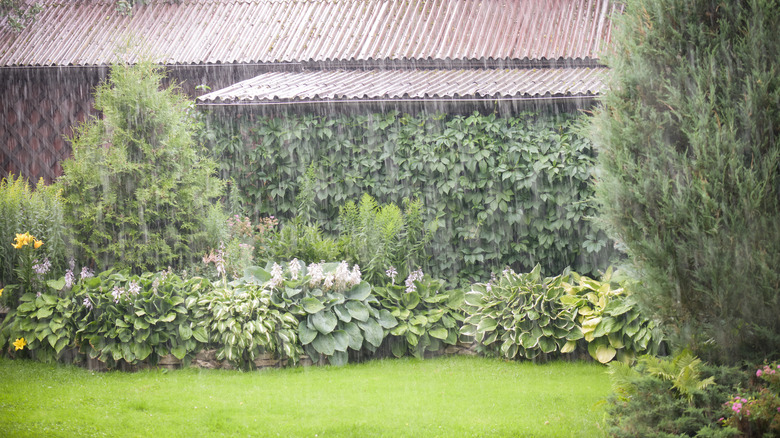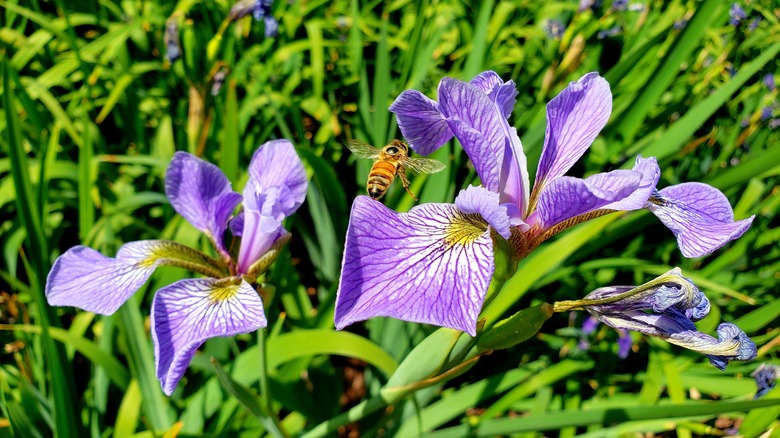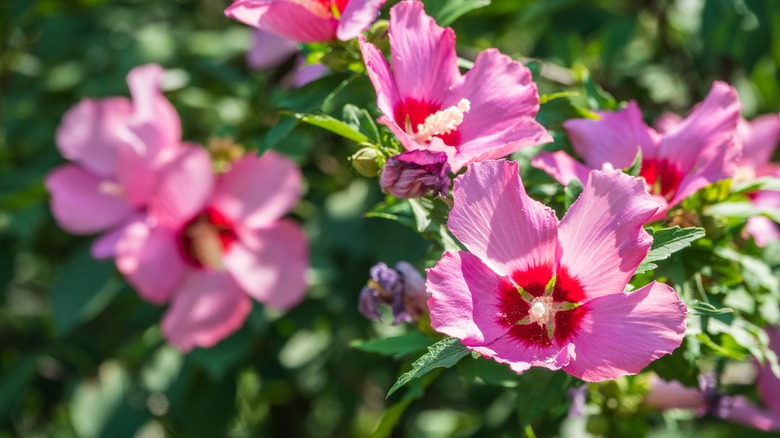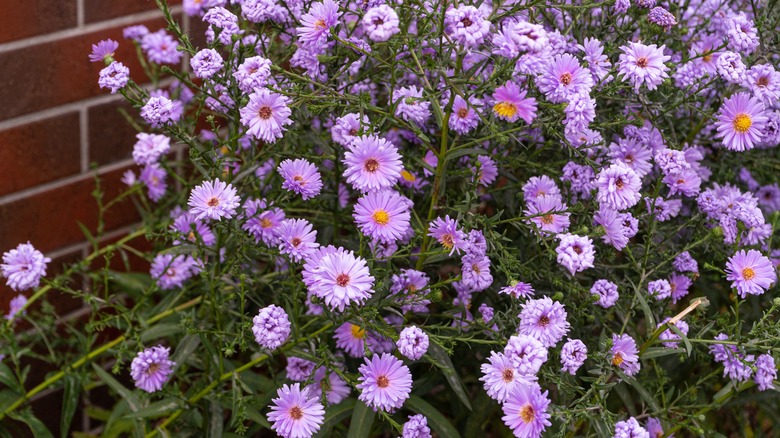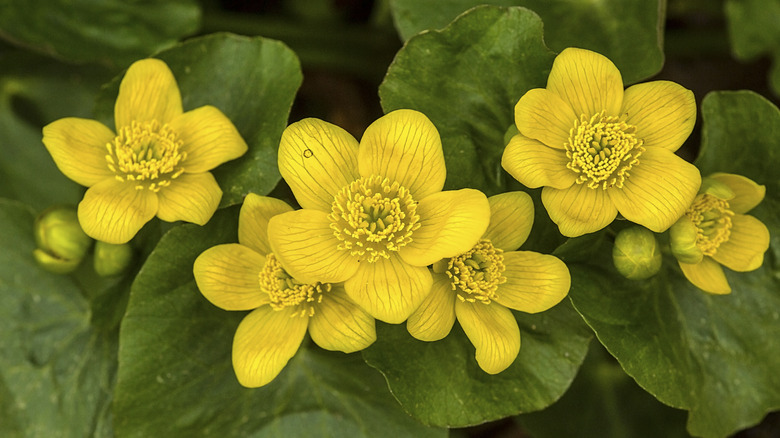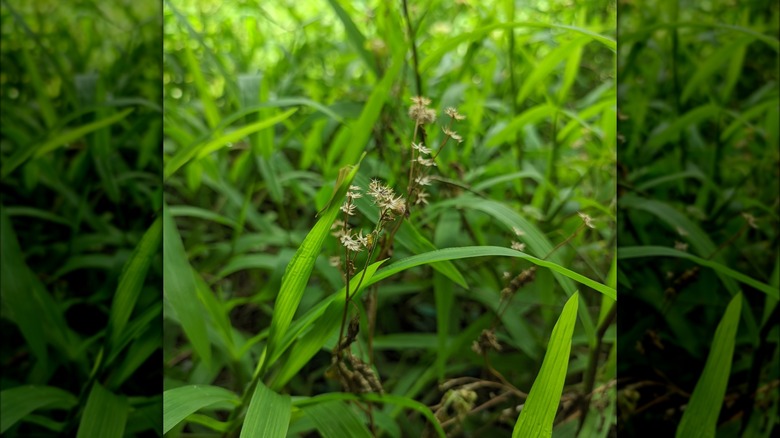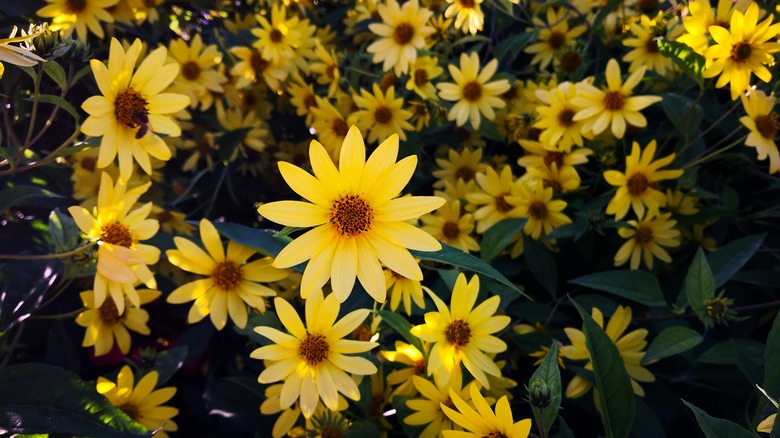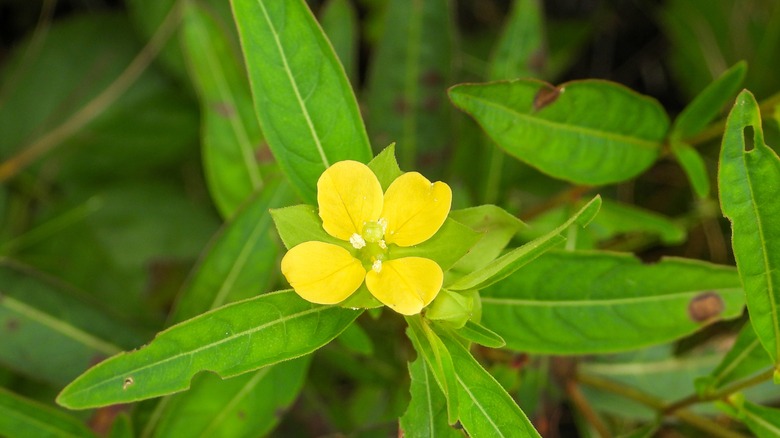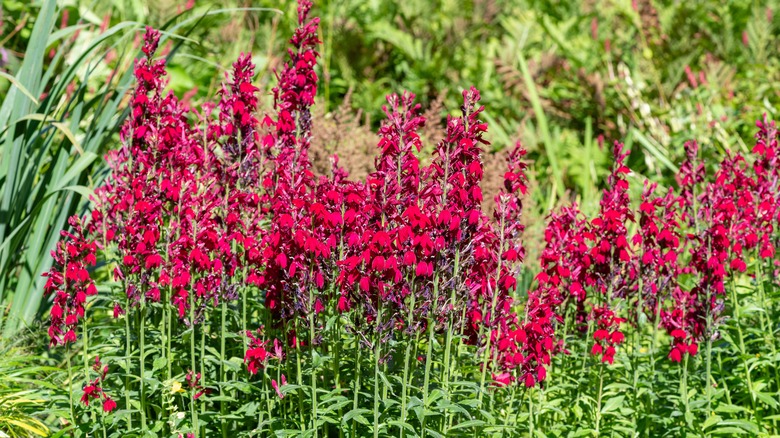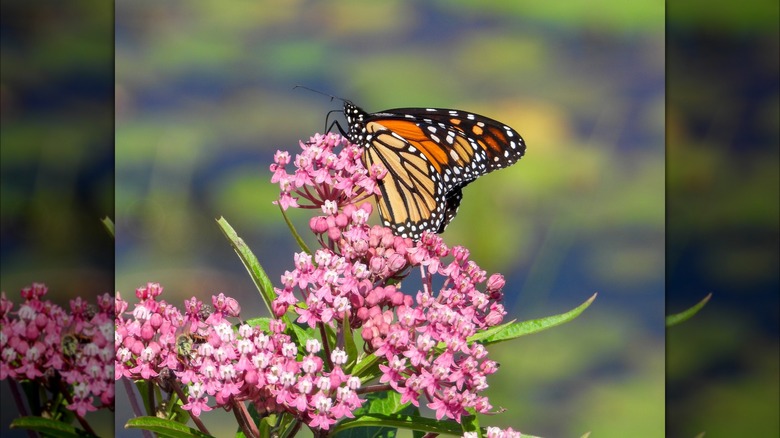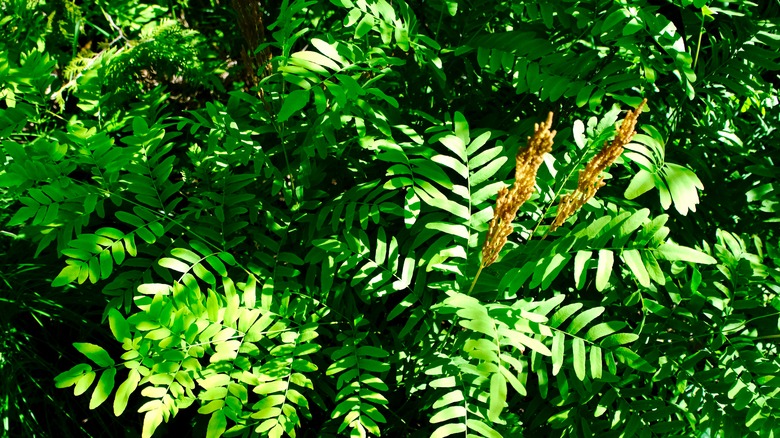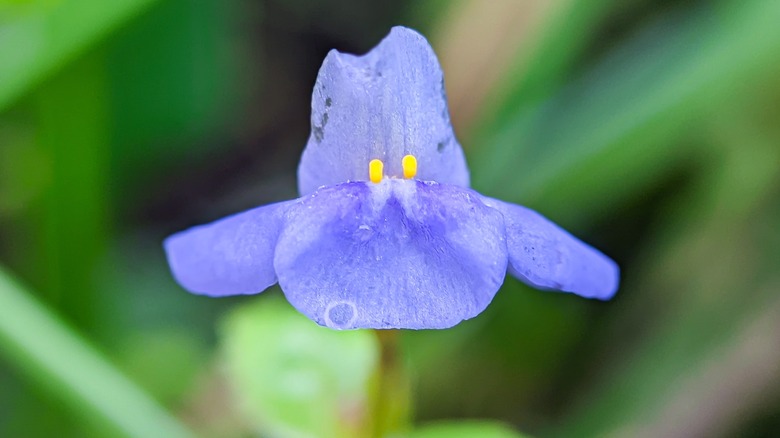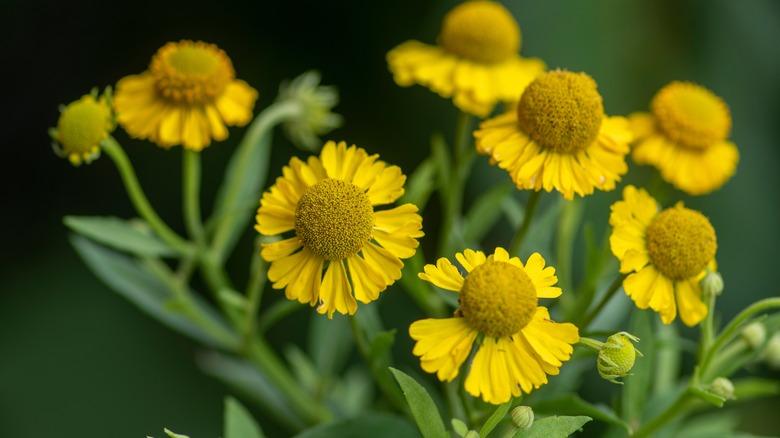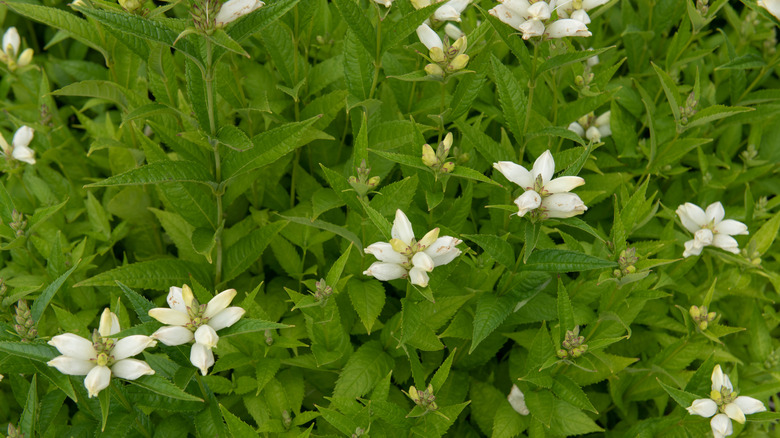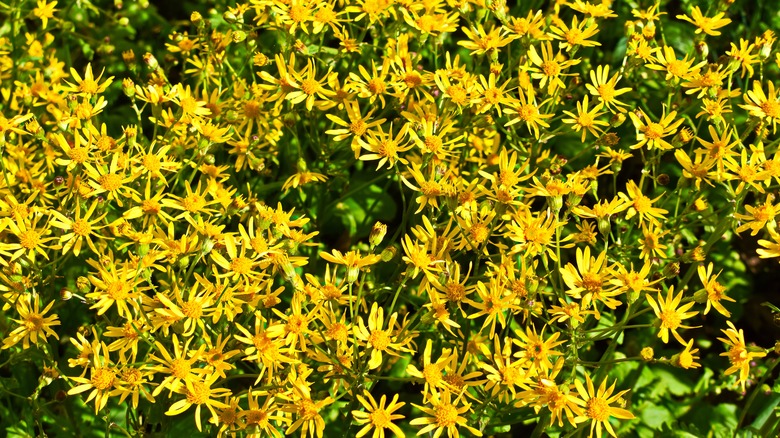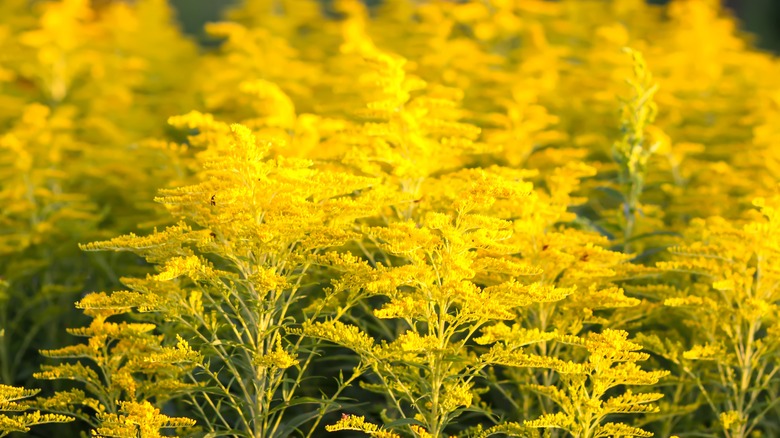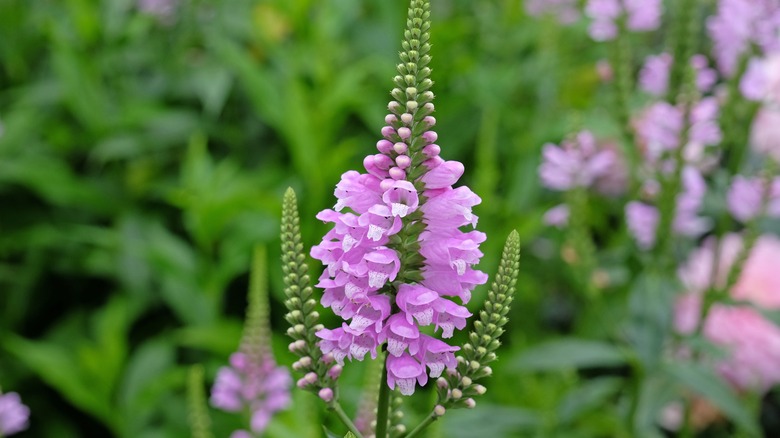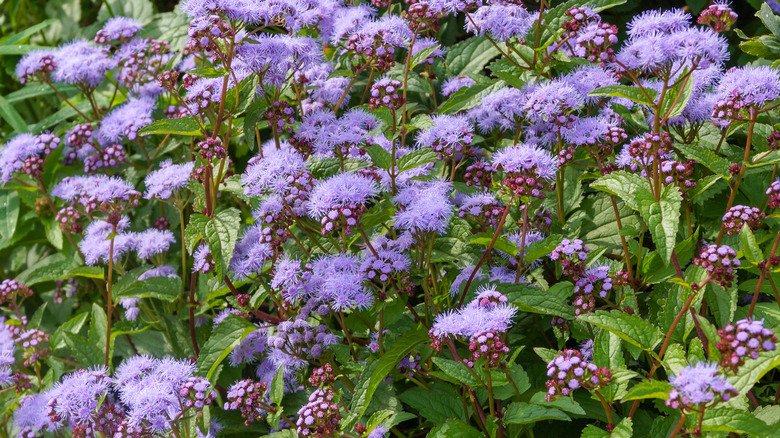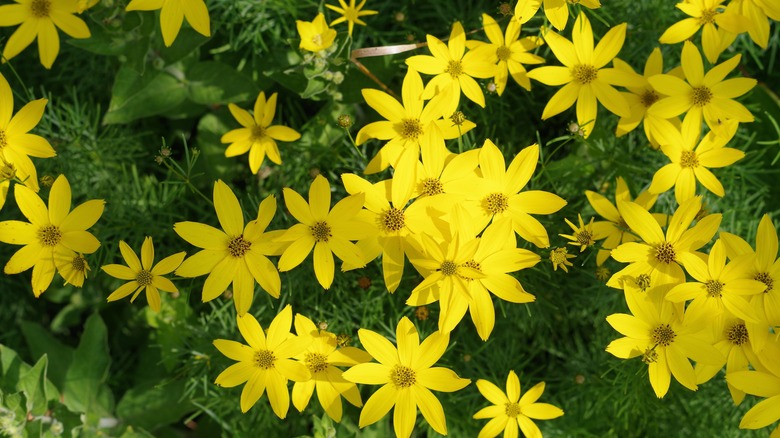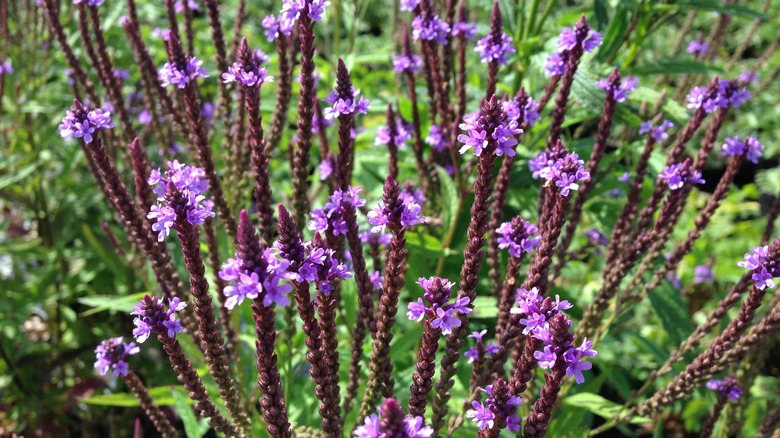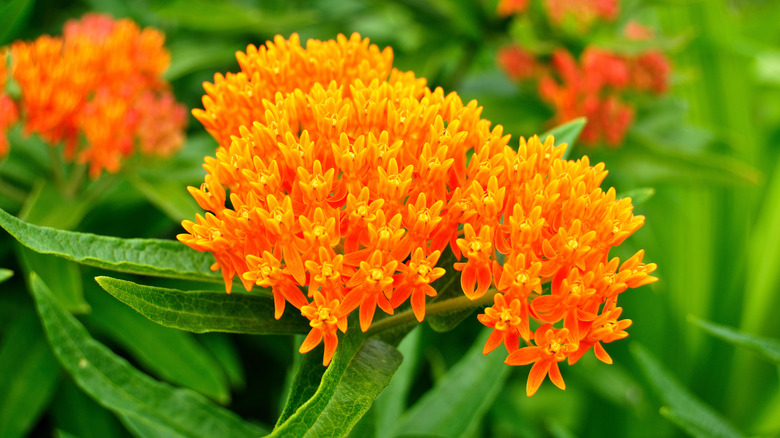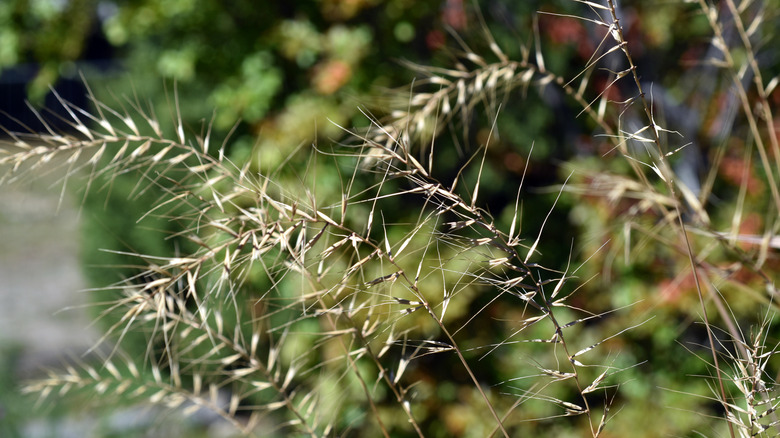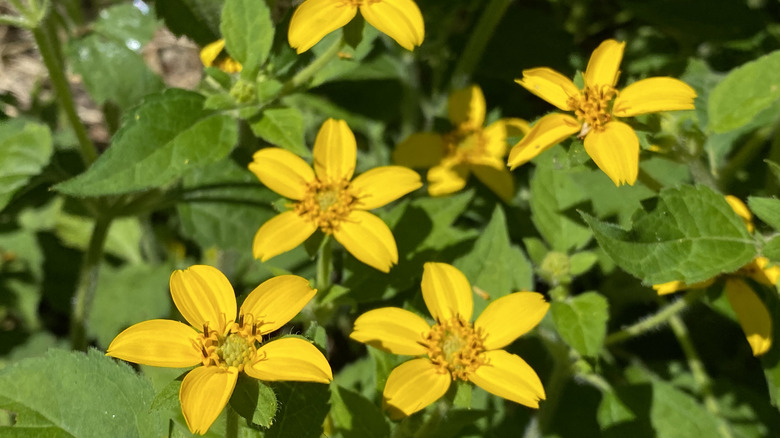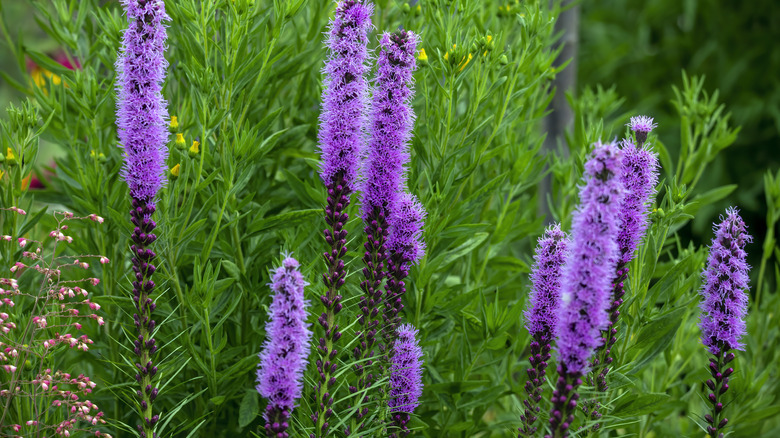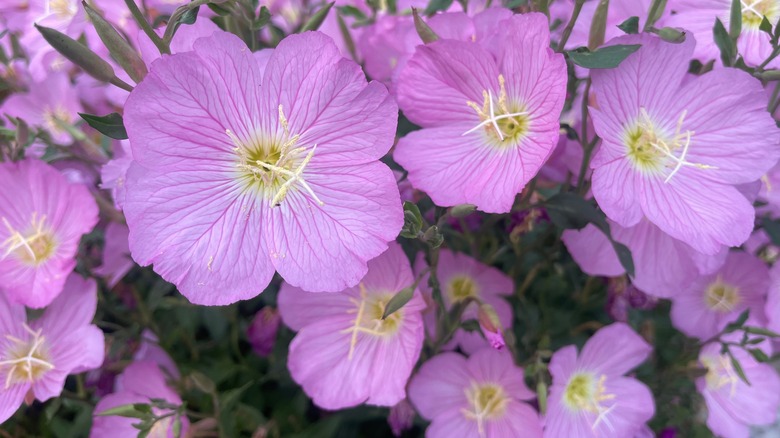24 Plants That Will Flood Your Rain Garden With Abundance
Appreciating a heavy downpour becomes infinitely easier when you have a rain garden, meaning you're no longer mulling over simple tricks for restoring your muddy lawn, backyard, or driveway and basking in your plant's verdant greenery instead. Stormwater management transforms from an ugly task to a breeze when you incorporate a rain garden. Welcome birds and pollinators to your space, all with the help of stormwater credits (if your municipality runs such programs). Your groundwater aquifers absorb their fill while the runoff gets increasingly filtered of pollutants, chemicals, and toxic waste, ensuring what pours into the natural creeks, lakes, or rivers is markedly cleaner — a momentous service to the ecosystem. That being said, choosing plants for your rain garden can be immensely complicated as much depends on their adaptability and the garden's depth.
Since there will be days when the rain garden won't receive any torrents, plants must be tolerant both to occasional flooding and to dry soils. Additionally, the site must meet their sun/shade requirements without compromising on layering and diversity. Most importantly, the plants should be positioned depending on how long they can stay inundated. Plus, most rain gardens are shaped like bowls, with runoff collecting at the bottom. This calls for plants that can bear standing in deep water for long periods (see numbers 1 to 15 in the ensuing list). The quick-draining areas along slanting slopes and the margins can support relatively less-enduring plants (the list's remainder), blending with the landscape seamlessly.
1. Harlequin blue flag iris
Submerge it in up to 4 inches of water if you like, but that won't stop the blue flag iris (Iris versicolor) from fanning out lance-like, bluish-green leaves which sharpen in the late spring into violet (rarely white) blooms. Native to the eastern region of the US, the iris plant grows 2½ feet tall and just as wide in full sun, although it can endure some shade. A compulsive self-seeder, the perennial demands little maintenance, but look out for iris borer and aphids. The deer-resistant plant is a hummingbird attractant, though keep your pets and ungloved hands away from its toxic roots, sap, and seeds.
2. Swamp or eastern rose mallow
Topped by huge, burgundy-eyed pink or white blooms, swamp rose mallow (Hibiscus moscheutos) are the native shrubs you want in your rain garden, especially if you're keen on enjoying the acrobatic fetes of hummingbirds, butterflies, and bees. The drought-resistant plants grow wider than tall and add much-needed winter interest (and food) through their chocolate brown seeds. Site them in sunny sites in USDA zones 5 through 8. Pinch the plants to stimulate bushy growth and remove the faded petals to extend their flowering season. Avoid planting them in areas with strong wind action.
3. New York aster
Exploding nectar-rich disk flowers in the fall, New York asters (Symphyotrichum novi-belgii) draw the willful attention of bees, moths, songbirds, and butterflies, enlivening the rain garden. Alternatively named Michaelmas daisy, the USDA zone 4 to 8 grower, tops out at 5 feet when positioned in full sun. However, if forced, it can survive in deep shade or infertile soils while resisting rabbit and deer pressure. Give it good drainage and plenty of space or it might contract powdery mildew. Divide the low-maintenance plants every 3 years for healthy growth. Couple with ornamental grasses or rudbeckia for color contrast.
4. Yellow marsh marigold
Aptly named only in part, marsh marigold (Caltha palustris) kicks off spring with its mass of buttercup yellow flowers, glistening brightly in the sun's rays, sans a shred of resemblance to marigolds. If their pollinators, aka hoverflies, could sneak in a word, they would say they love the UV rays that shine off the plants' blossoms. Listed as endangered in North Carolina and Tennessee, marsh marigolds' clumps can be separated to create new plants or they can be allowed to go to seed. Try coupling the deer-resistant perennials with skunk cabbage but steer clear of legumes; marsh marigolds are greedy and can crowd them out.
5. Green bulrush
Prevalent throughout most of the United States, green bulrush (Scirpus atrovirens) is a coarse-edged, green sedge relative, most often grown to shield neighboring aquatic plants from winds with its 4-foot stature. Its flowery spikelets aren't anything to write home about but persist through the fall, complementing the fall-changing ochre foliage soundly, while serving songbirds and waterfowl with food and shelter. If left thirsting for water for extended periods, bulrushes develop yellowing foliage. Plant in full sun if you can. When left unchecked, they establish colonies through runners and seeds — hence they are labeled weedy in Wisconsin.
6. Swamp sunflower
Sprouting willowy, slender green leaves that are about as pleasant to touch as sandpaper, swamp sunflowers (Helianthus angustifolius) come into their own in fall (or late summer, depending on the location) when they're decked in yellow daisy-esque flowers. Capable of growing 4 feet across and 8 feet tall in acidic soils of USDA zones 5 to 9, swamp sunflowers need a wide berth to grow. While they multiply through rhizomes, they don't become weedy. Place this perennial in full sun (or light shade) and stake them in windy locations to watch pollinators and songbirds sipping their nectar.
7. Alternate-leaved seedbox
Named after its distinctly square fruit, seedbox (Ludwigia alternifolia) is a low-growing, perennial wildflower found in tidal marshes and swamps. Festooned with sunny yellow, saucer-shaped blooms from summer through fall, seedbox hosts droves of bees, butterflies, and seed beetles. It prefers sandy soils with a dash of acidity but will withstand clay textures if they remain sufficiently damp. Grow the heat-tolerant perennials in USDA zones 4 to 8 in direct sun, but avoid around deer and voles.
8. Cardinal flower
Bursting forth silky red-lipped blooms from summer through fall, the cardinal flower (Lobelia cardinalis) is the colorful flower you should add to your garden to attract hummingbirds and butterflies without letting deer and rabbits join in for a scoop. Their love for wet-mesic soils is strong enough to adapt to full sun in southern climates. However, their best performance comes through in partially shaded, fertile sites, with cinnamon ferns and mistflowers serving as dashing companions. They're susceptible to rust and leaf spots, so clean up leaf litter pre-winter. They are unsuitable around curious pets and humans as they are toxic if ingested.
9. Swamp milkweed
Someone's poison is another's treasure, and swamp milkweed (Asclepias incarnata) embodies the dichotomy like no other. Its toxic sap warns off most mammals, including deer and rabbits, making monarch butterflies feel safe about laying their eggs on the deciduous foliage. When grown in moist, sunny sites in growth zones 3 to 9, they can reach 5 feet high. Exploding in aromatic, fuchsia pink or white umbels come summer, they entice pollinators right up to the first frost. While it's easy to get free milkweed seeds for a stunning butterfly garden, they may take many years to put out blooms.
10. Royal fern
Botanically renamed Osmunda spectabilis (formerly, regalis), the royal fern is a clump-forming, nearly 6-foot-tall native species that loves moisture and dappled-to-deep shade. It doesn't produce any flowers but draws the eyes through its spore-producing tannish-red tassels, shooting out of its green fronds with spring's onset. It lends fall interest to rain gardens with golden brown fronds through autumn. Quick to root in acidic soils of zones 3 through 9, royal ferns take their sweet time in spreading wide. Note that royal ferns should not be planted near hydrangeas.
11. Allegheny monkey flower
Prevalent across North America's swamps and marshy meadows, Allegheny monkey flower (Mimulus ringens) is another contender for your rain garden both for its adaptability and ornamental beauty. Its tubular flowers are available in an array of colors, including burgundy, lilac, and blue, but being two-lipped, they give off the impression of a laughing monkey, which explains their name. Interestingly, their mottled centers serve as landing pads, directing pollinators like bees to the nectar, though hummingbirds and butterflies are just as attracted. It's hardy in zones 3 to 8, and these deer-impervious perennials do well in partial shade and full sun.
12. Autumn sneezeweed
Named for their propensity to bloom their yellow ray flowers all through the fall season, autumn sneezeweed (Helenium autumnale) perennials are a go-to for wet soils. If unpruned, these sun-lovers mature to heights of over 5 feet, necessitating staking. However, it's best to give them a haircut as the summer is setting in to keep them tidy and bushy. To propagate these daisy members, favor separating the clumps, given the poor seed germination rates. Sneezeweed defends itself against pathogens through Sesquiterpene lactone chemicals that unfortunately make it deadly toxic for humans. Butterflies and songbirds adore this deer- and rabbit-resistant plant.
13. White turtlehead
Another moderate shade-lover, white turtlehead (Chelone glabra) paints the rain garden a luxuriant green with its serrated, sword-shaped foliage. It eventually adds a creamy white contrast with a few pink speckles thrown in between through two-lipped flowers right into fall. Generally pest- and disease-resistant, dry conditions may stress the perennial into contracting mildew, so choose their site wisely. These plants can reach over 2 feet high and similarly wide in organically rich soils in USDA zones 3 through 8. They appeal to butterflies' and hummingbirds' daydreams. The plant can tolerate alkaline substrates.
14. Golden ragwort
Hardy in zones 3 and above, Golden ragwort (Packera aurea) is a relatively disease- and pest-free option in rain gardens, especially as a ground cover. Shade doesn't dim its appeal by any means, as it continues to produce its yellow flowers atop heart-shaped, green foliage through the spring, although full sun will be better. Position the fast-growing perennial where you can enjoy a view of the various songbirds and bees darting into for its nectar and seeds. Pruning may be necessary to keep the plant neat and control its spread. Use gloves before touching the foliage to avoid skin irritation from its toxic leaves.
15. Rough goldenrod
If you need some color to cheer you up while checking chores off your fall cleanup list, rough goldenrod (Solidago rugosa) might fit the bill. Its yellow flowers are quite attractive — take it from the honeybees, butterflies, and songbirds who risk it all for it — and can be added to your floral arrangements. Don't blame the self-seeding plant for causing hay fever, as airborne pollen is emanating from ragweed that blooms at the same time. Grow it in sun or light shade, as the site allows in USDA zones 4 to 8, and watch it scale 4 feet.
16. Obedient plant
With "false dragon head" as a moniker, perhaps you can venture that the obedient plant (Physostegia virginiana) supports tall spikes of rosy pink or mauve flowers much like its namesake — only more elaborate. Hardy down to zone 2, these perennials have won over hummingbirds and butterflies who hover around it all season long. While its flowers stay in their place obediently, hence the name, the same can't be said about their stems, prompting the need for staking. To prevent the 4-foot-tall plants from spreading, separate them annually and pull out the errant, shallow roots.
17. Mistflower
Long-time gardeners probably recognize these fuzzy purple flowers as Hardy ageratum though they are also known as Mistflower (Conoclinium colestinum). Native to the eastern US region, the 2-foot-tall plant can choke the surrounding vegetation if your soils are highly fertile and moist, reducing their suitability in small gardens. However, dividing their clumps every spring keeps them in check. Excessive shade may prompt the wildflowers to bunch into thickets, so give them full sun if you don't want that look. They're cold hardy in USDA zones 6 through 11. Aphids, leaf miners, and powdery mildew may be a problem.
18. Threadleaf coreopsis
The solid lime-yellow flowers of threadleaf coreopsis (Coreopsis verticillata) pack a massive punch despite their size, resisting rabbits, deer, salt, heat, and humidity as if most other plants aren't routinely killed when such elements band together. Their love for poor soils runs so strong that they tend to flop down when fed fertilizers. The flowers can bloom into the fall, keeping the floral fiesta on for a long time. The long-lived clumps are quick to spread and must be split every couple of years, lest they turn into unruly neighbors.
19. Blue vervain
Rampant across the marshy North American parts, blue vervain (Verbena hastata) is one self-seeding perennial you want in your rain garden, not just for its purple blooms but to experience its monogamous relationship with verbena bees, first hand. Besides, as these plants open from bottom to top, you can enjoy a variety of wildlife with pollinators and hummingbirds relishing the flowers while cardinals and juncos pick the seeds off the ripe fruit below. Usually low maintenance, blue vervains are best grown in full sun in growth zones 3 to 8.
20. Butterfly weed
Producing oodles of nectar-rich orange, red, or yellow flowers, butterfly weed (Asclepias tuberosa) or chigger flower as it's sometimes called, keeps monarch butterflies, hummingbirds, and tussock moths fed and content, which naturally rubs off the gardeners, too. Removing faded flowers encourages reblooming, in addition to keeping the long-lived perennial's self-seeding tendencies under control. Exotic oleander aphids can terrorize the plant but can be hosed down. Direct seeding will delay flowering for three years, so start with cuttings. As the natives despise transplantation, get their location right on the first try — their tolerance for wet soils stops at poor drainage.
21. Bottlebrush grass
For a no-fuss ground cover in lightly shaded or dappled sites, consider bottlebrush grass (Elymus hystrix), a cool-season grass indigenous to woodland gardens rather than prairies, as is typical for most native ornamentals. When left to their devices, the clumps can grow nearly 4 feet high in growth zones 5 through 9. Let them go to seed (they won't turn aggressive) because certain songbirds depend on it for food. Trim the grassy plant in early spring to maintain vigor but be prepared for it to go dormant in peak summers.
22. Green and gold
Alternatively called goldenstar after its stellate yellow blooms, the shade-loving, low-growing green and gold plant (Chrysogonum virginianum) is another worthy addition to your rain garden. But you must provide it with acidic, well-draining soils, so work in compost or lime if necessary. Although you can grow the wildflower in the sun, it'll need consistent water and mulch to keep the floral display going for its admirers, aka songbirds and pollinators. Cold hardy to zone 5, the East American native adds winter interest with its semi-evergreen foliage. Avoid the australe variety, as it can become weedy.
23. Marsh blazing star
Renowned as a beautiful plant that will thrive in clay soil, be it dry or wet, marsh blazing star (Liatris spicata) looks stunning planted in drifts in rain gardens. When not actively blooming its lilac or pink (seldom white) bottlebrush-shaped flowers during summers, it passes off as sprigs of grass thanks to its slender, glabrous leaves. Keep the bulbous perennial away from fertile sites, or it'll grow leggy, necessitating support. Site in full sun so that hummers and bees can appreciate its full glory while goldfinches stomach the seeds. Don't overcrowd the beds to keep diseases at bay.
24. Evening primrose
The opposite of hibiscus, evening primrose's (Oenothera speciosa) golden flowers open at dusk after the sun has sunk into the horizon and close when it's back out in full blast. That's why they release a faint lemony fragrance to catch the attention of night-flying moths or early-rising bees to aid with pollination. Grow them using plugs unless you're ready to wait for three years for the seeds to germinate and burst flowers. Primroses attract beneficial insects, which makes them a good plant to have around, although Japanese beetles and lygus bugs may be attracted to them.
